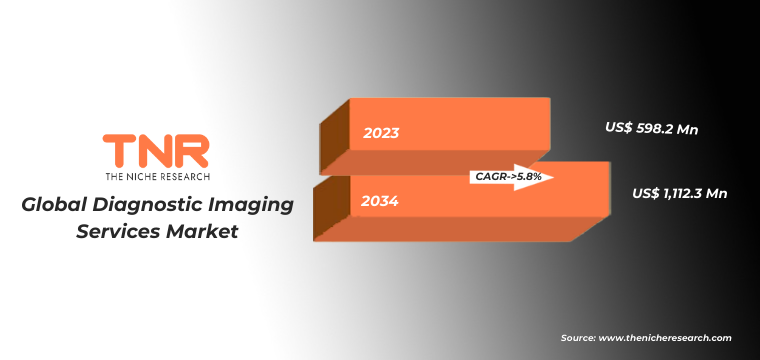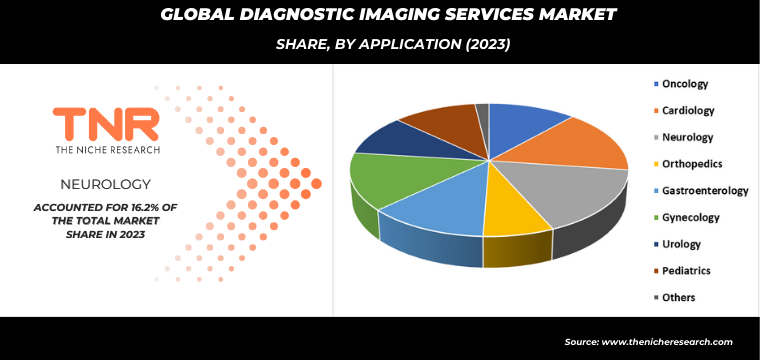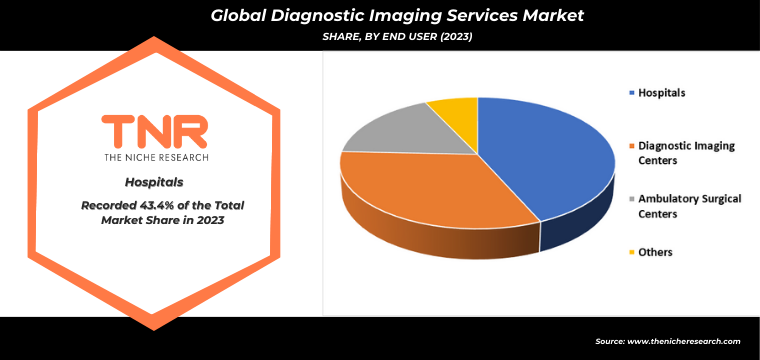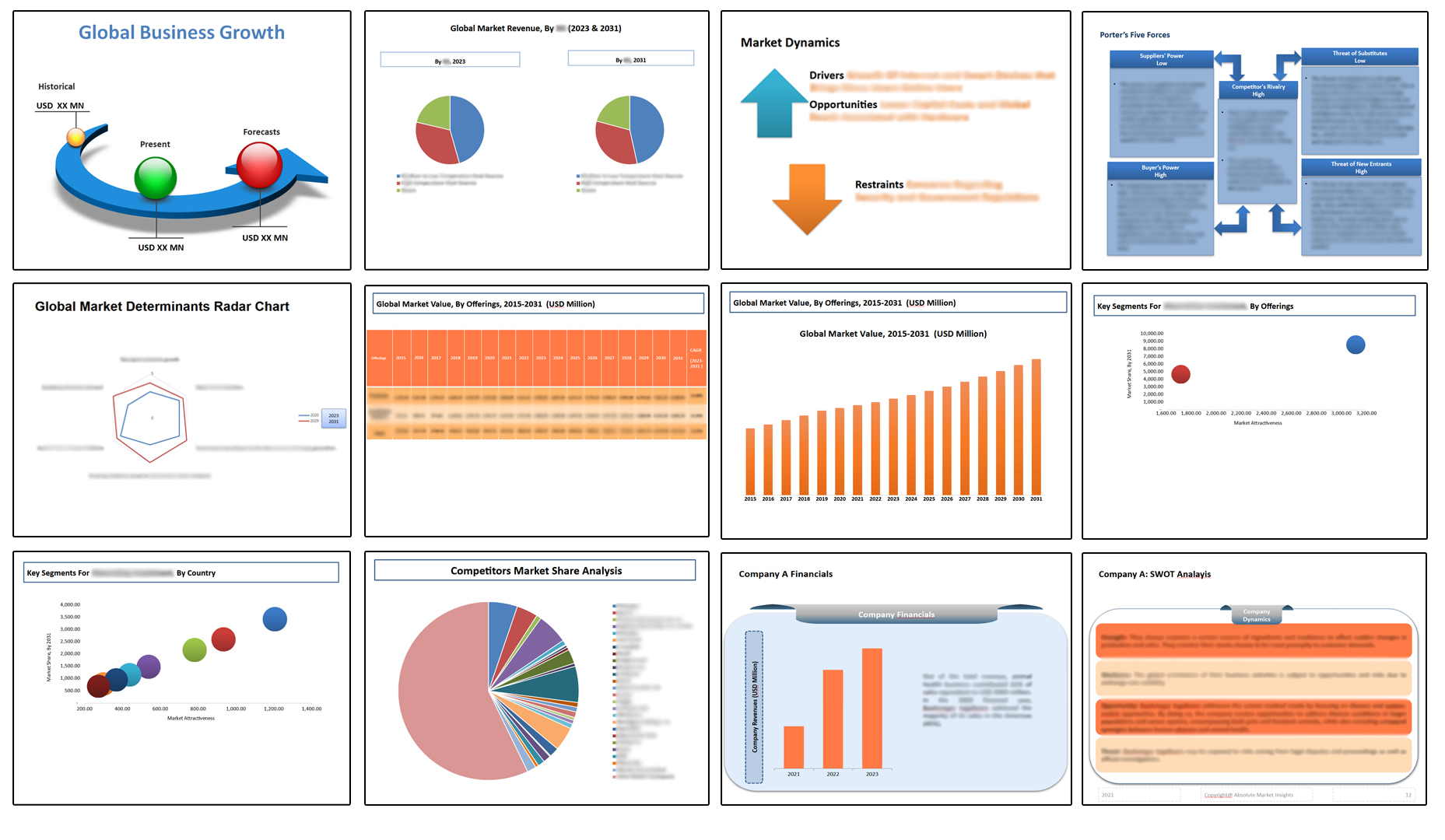Global Diagnostic Imaging Services Market By Service Type, By Application, By End User, By Region & Segmental Insights Trends and Forecast, 2024 – 2034
- Industry: Healthcare
- Report ID: TNR-110-1063
- Number of Pages: 420
- Table/Charts : Yes
- April, 2024
- Base Year : 2024
- No. of Companies : 10+
- No. of Countries : 29
- Views : 10144
- Covid Impact Covered: Yes
- War Impact Covered: Yes
- Formats : PDF, Excel, PPT
The global diagnostic imaging services market is witnessing robust growth driven by factors such as increasing prevalence of chronic diseases, technological advancements in imaging modalities, and growing demand for early and accurate diagnosis. Rising healthcare expenditure, coupled with expanding healthcare infrastructure in emerging economies, further propels market expansion.
The market encompasses a wide range of imaging modalities, including X-ray, CT, MRI, ultrasound, nuclear medicine, and fluoroscopy, catering to diverse medical specialties such as oncology, cardiology, neurology, and orthopaedics. In terms of revenue, the global diagnostic imaging services market was worth US$ 598.2 Mn in 2023 and is anticipated to witness a CAGR of 5.8% during 2024 – 2034.
Global Diagnostic Imaging Services Market Revenue & Forecast, (US$ Million), 2016 – 2034

Overview Global Diagnostic Imaging Services Market
The global diagnostic imaging services market plays a crucial role in modern healthcare by providing essential tools for the early detection, diagnosis, and monitoring of various medical conditions. Diagnostic imaging services encompass a wide range of modalities, including X-ray, computed tomography (CT), magnetic resonance imaging (MRI), ultrasound, nuclear medicine, fluoroscopy, mammography, and others. These modalities offer detailed visualization of internal body structures, aiding healthcare professionals in making informed decisions regarding patient care.
One of the primary drivers of the global diagnostic imaging services market is the increasing prevalence of chronic diseases such as cancer, cardiovascular disorders, and neurological conditions. These diseases often require imaging for accurate diagnosis and staging, driving the demand for diagnostic imaging services. Additionally, the aging population worldwide contributes to the rising demand for imaging services, as older individuals are more prone to age-related illnesses and conditions that necessitate diagnostic imaging.
Technological advancements have significantly impacted the diagnostic imaging services market, leading to the development of more advanced and sophisticated imaging modalities. Innovations such as digital imaging, 3D and 4D imaging, contrast-enhanced imaging, and artificial intelligence (AI) integration have improved imaging quality, accuracy, and efficiency. These advancements enable healthcare providers to diagnose conditions earlier, facilitate minimally invasive procedures, and enhance patient outcomes.
Furthermore, there is a growing emphasis on preventive healthcare and early detection initiatives, driven by government healthcare policies and public awareness campaigns. Screening programs for conditions like breast cancer, lung cancer, and cardiovascular diseases have increased the utilization of diagnostic imaging services for early detection and intervention.

X-ray segment in service type dominated the global market during the forecast period. X-ray imaging remains one of the most widely used and cost-effective modalities for diagnosing a wide range of medical conditions, including fractures, pneumonia, dental issues, and certain tumors. Its widespread availability, ease of use, and relatively low cost make it an indispensable tool in healthcare settings worldwide. Additionally, technological advancements such as digital X-ray systems have improved image quality, reduced radiation exposure, and enhanced workflow efficiency, further driving the adoption of X-ray imaging services. Moreover, the increasing prevalence of chronic diseases and the rising demand for preventive healthcare initiatives contribute to the continued growth and dominance of the X-ray segment in the diagnostic imaging services market.

By application, the cardiology segment is expected to gain popularity in future years and is anticipated to grow the fastest over the forecast timeline. Cardiovascular diseases (CVDs) remain a leading cause of morbidity and mortality worldwide, necessitating frequent diagnostic imaging for early detection and monitoring. As the prevalence of CVDs continues to rise, there is a growing demand for advanced imaging modalities such as cardiac MRI, CT angiography, and nuclear cardiology.
Additionally, technological advancements in cardiac imaging have improved diagnostic accuracy, enabling detailed assessment of cardiac anatomy, function, and blood flow dynamics. Moreover, increasing awareness about the importance of preventive cardiology and the adoption of guideline-based imaging protocols further drive the growth of the cardiology segment in the diagnostic imaging services market.

Hospitals segment by end user accounted for the largest revenue share in 2023 in the global market. Hospitals serve as primary healthcare centers where patients receive a wide range of medical services, including diagnostic imaging, under one roof. The high patient volume in hospitals ensures a consistent demand for diagnostic imaging services. Additionally, hospitals often have advanced imaging equipment and specialized healthcare professionals, enabling them to offer a comprehensive range of imaging modalities to cater to various medical specialties and complex cases.
Moreover, hospitals typically have robust infrastructure and financial resources to invest in the latest imaging technologies, ensuring high-quality diagnostic services and driving revenue growth in the diagnostic imaging services market.
Asia Pacific is expected to emerge as the second-leading region in the diagnostic imaging services market, following North America. Rapid economic development in countries like China, India, and Japan has led to increased healthcare expenditure and investment in healthcare infrastructure, including diagnostic imaging facilities. Additionally, the region has a large and aging population, leading to a higher prevalence of chronic diseases that necessitate diagnostic imaging services.

Moreover, improving healthcare access and rising awareness about preventive healthcare measures further drive the demand for diagnostic imaging services in Asia Pacific. Furthermore, advancements in technology and increasing collaborations with global healthcare providers are enhancing the availability and quality of diagnostic imaging services, contributing to the region’s growth in the diagnostic imaging services market.
Competitive Landscape
Key strategies among competitors include technological advancements, strategic partnerships, mergers, and acquisitions. Established companies focus on expanding their service portfolios, while emerging players often prioritize innovation and cost-effective solutions to gain market share in this rapidly evolving sector. Some of the players operating in the diagnostic imaging services market are
- Alliance Medical Inc
- Concord Medical Services Holdings Limited
- Dignity Health Incorporation
- Hoffmann-La Roche AG
- Global Diagnostics Corp.
- Healthcare Imaging Services Pty Ltd
- InHealth Group
- Medica Group
- Novant Health Group
- Quest Diagnostics Inc.
- RadNet, Inc
- Sonic Healthcare Corporation
- Sysmex Corporation
- Thermo Fisher Scientific.
- Other Industry Participants
Global Diagnostic Imaging Services Market: Key Takeaways
| Report Specifications | Details |
| Market Revenue in 2023 | US$ 598.2 Mn |
| Market Size Forecast by 2034 | US$ 1,112.3 Mn |
| Growth Rate (CAGR) | 5.8% |
| Historic Data | 2016 – 2022 |
| Base Year for Estimation | 2023 |
| Forecast Period | 2024 – 2034 |
| Report Inclusions | Market Size & Estimates, Market Dynamics, Competitive Scenario, Trends, Growth Factors, Market Determinants, Key Investment Segmentation, Product/Service/Solutions Benchmarking |
| Segments Covered | By Service Type, By Application, By End User |
| Regions Covered | North America, Europe, Asia Pacific, Middle East & Africa, Latin America |
| Countries Covered | U.S., Canada, Mexico, Rest of North America, France, The UK, Spain, Germany, Italy, Nordic Countries (Denmark, Finland, Iceland, Sweden, Norway), Benelux Union (Belgium, The Netherlands, Luxembourg), Rest of Europe, China, Japan, India, New Zealand, Australia, South Korea, Southeast Asia (Indonesia, Thailand, Malaysia, Singapore, Rest of Southeast Asia), Rest of Asia Pacific, Saudi Arabia, UAE, Egypt, Kuwait, South Africa, Rest of Middle East & Africa, Brazil, Argentina, Rest of Latin America |
| Key Players | Alliance Medical Inc, Concord Medical Services Holdings Limited, Dignity Health Incorporation, F. Hoffmann-La Roche AG, Global Diagnostics Corp., Healthcare Imaging Services Pty Ltd, InHealth Group, Medica Group, Novant Health Group, Quest Diagnostics Inc., RadNet, Inc, Sonic Healthcare Corporation, Sysmex Corporation, Thermo Fisher Scientific, Other Industry Participants |
| Customization Scope | Customization allows for the inclusion/modification of content pertaining to geographical regions, countries, and specific market segments. |
| Pricing & Procurement Options | Explore purchase options tailored to your specific research requirements |
| Contact Details | Consult With Our Expert
Japan (Toll-Free): +81 663-386-8111 South Korea (Toll-Free): +82-808- 703-126 Saudi Arabia (Toll-Free): +966 800-850-1643 United Kingdom: +44 753-710-5080 United States: +1 302-232-5106 E-mail: askanexpert@thenicheresearch.com
|
Global Diagnostic Imaging Services Market
By Service Type
- X-ray
- Computed Tomography (CT)
- Magnetic Resonance Imaging (MRI)
- Ultrasound
- Nuclear Imaging
- Fluoroscopy
- Mammography
- Others
By Application
- Oncology
- Cardiology
- Neurology
- Orthopaedics
- Gastroenterology
- Gynaecology
- Urology
- Paediatrics
- Others
By End User
- Hospitals
- Diagnostic Imaging Centers
- Ambulatory Surgical Centers
- Others
By Region
- North America (U.S., Canada, Mexico, Rest of North America)
- Europe (France, The UK, Spain, Germany, Italy, Nordic Countries (Denmark, Finland, Iceland, Sweden, Norway), Benelux Union (Belgium, The Netherlands, Luxembourg), Rest of Europe)
- Asia Pacific (China, Japan, India, New Zealand, Australia, South Korea, Southeast Asia (Indonesia, Thailand, Malaysia, Singapore, Rest of Southeast Asia), Rest of Asia Pacific)
- Middle East & Africa (Saudi Arabia, UAE, Egypt, Kuwait, South Africa, Rest of Middle East & Africa)
- Latin America (Brazil, Argentina, Rest of Latin America)
Report Layout

Table of Contents
Note: This ToC is tentative and can be changed according to the research study conducted during the course of report completion.
**Exclusive for Multi-User and Enterprise User.
Global Diagnostic Imaging Services Market
By Service Type
- X-ray
- Computed Tomography (CT)
- Magnetic Resonance Imaging (MRI)
- Ultrasound
- Nuclear Imaging
- Fluoroscopy
- Mammography
- Others
By Application
- Oncology
- Cardiology
- Neurology
- Orthopaedics
- Gastroenterology
- Gynaecology
- Urology
- Paediatrics
- Others
By End User
- Hospitals
- Diagnostic Imaging Centers
- Ambulatory Surgical Centers
- Others
By Region
- North America (U.S., Canada, Mexico, Rest of North America)
- Europe (France, The UK, Spain, Germany, Italy, Nordic Countries (Denmark, Finland, Iceland, Sweden, Norway), Benelux Union (Belgium, The Netherlands, Luxembourg), Rest of Europe)
- Asia Pacific (China, Japan, India, New Zealand, Australia, South Korea, Southeast Asia (Indonesia, Thailand, Malaysia, Singapore, Rest of Southeast Asia), Rest of Asia Pacific)
- Middle East & Africa (Saudi Arabia, UAE, Egypt, Kuwait, South Africa, Rest of Middle East & Africa)
- Latin America (Brazil, Argentina, Rest of Latin America)
The Niche Research approach encompasses both primary and secondary research methods to provide comprehensive insights. While primary research is the cornerstone of our studies, we also incorporate secondary research sources such as company annual reports, premium industry databases, press releases, industry journals, and white papers.
Within our primary research, we actively engage with various industry stakeholders, conducting paid interviews and surveys. Our meticulous analysis extends to every market participant in major countries, allowing us to thoroughly examine their portfolios, calculate market shares, and segment revenues.
Our data collection primarily focuses on individual countries within our research scope, enabling us to estimate regional market sizes. Typically, we employ a bottom-up approach, meticulously tracking trends in different countries. We analyze growth drivers, constraints, technological innovations, and opportunities for each country, ultimately arriving at regional figures.Our process begins by examining the growth prospects of each country. Building upon these insights, we project growth and trends for the entire region. Finally, we utilize our proprietary model to refine estimations and forecasts.
Our data validation standards are integral to ensuring the reliability and accuracy of our research findings. Here’s a breakdown of our data validation processes and the stakeholders we engage with during our primary research:
- Supply Side Analysis: We initiate a supply side analysis by directly contacting market participants, through telephonic interviews and questionnaires containing both open-ended and close-ended questions. We gather information on their portfolios, segment revenues, developments, and growth strategies.
- Demand Side Analysis: To gain insights into adoption trends and consumer preferences, we reach out to target customers and users (non-vendors). This information forms a vital part of the qualitative analysis section of our reports, covering market dynamics, adoption trends, consumer behavior, spending patterns, and other related aspects.
- Consultant Insights: We tap into the expertise of our partner consultants from around the world to obtain their unique viewpoints and perspectives. Their insights contribute to a well-rounded understanding of the markets under investigation.
- In-House Validation: To ensure data accuracy and reliability, we conduct cross-validation of data points and information through our in-house team of consultants and utilize advanced data modeling tools for thorough verification.
The forecasts we provide are based on a comprehensive assessment of various factors, including:
- Market Trends and Past Performance (Last Five Years): We accurately analyze market trends and performance data from preceding five years to identify historical patterns and understand the market’s evolution.
- Historical Performance and Growth of Market Participants: We assess the historical performance and growth trajectories of key market participants. This analysis provides insights into the competitive landscape and individual company strategies.
- Market Determinants Impact Analysis (Next Eight Years): We conduct a rigorous analysis of the factors that are projected to influence the market over the next eight years. This includes assessing both internal and external determinants that can shape market dynamics.
- Drivers and Challenges for the Forecast Period:Identify the factors expected to drive market growth during the forecast period, as well as the challenges that the industry may face. This analysis aids in deriving an accurate growth rate projection.
- New Acquisitions, Collaborations, or Partnerships: We keep a close watch on any new acquisitions, collaborations, or partnerships within the industry. These developments can have a significant impact on market dynamics and competitiveness.
- Macro and Micro Factors Analysis:A thorough examination of both macro-level factors (e.g., economic trends, regulatory changes) and micro-level factors (e.g., technological advancements, consumer preferences) that may influence the market during the forecast period.
- End-User Sentiment Analysis: To understand the market from the end-user perspective, we conduct sentiment analysis. This involves assessing the sentiment, preferences, and feedback of the end-users, which can provide valuable insights into market trends.
- Perspective of Primary Participants: Insights gathered directly from primary research participants play a crucial role in shaping our forecasts. Their perspectives and experiences provide valuable qualitative data.
- Year-on-Year Growth Trend: We utilize a year-on-year growth trend based on historical market growth and expected future trends. This helps in formulating our growth projections, aligning them with the market’s historical performance.
Research process adopted by TNR involves multiple stages, including data collection, validation, quality checks, and presentation. It’s crucial that the data and information we provide add value to your existing market understanding and expertise. We have also established partnerships with business consulting, research, and survey organizations across regions and globally to collaborate on regional analysis and data validation, ensuring the highest level of accuracy and reliability in our reports.









